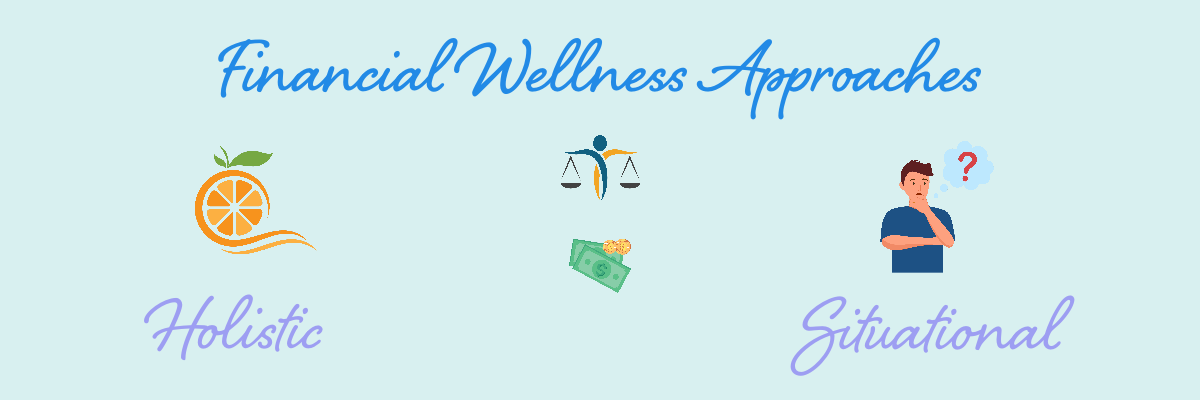


Saturday, July 22, 2023
There are a wide variety of financial wellness solutions available. Learn how to build a program that provides a positive ROI for your company and delivers results for your employees.
Financial wellness solutions seemingly come in all shapes and sizes which makes it difficult for employers to find the right fit for their employees. It takes careful consideration and planning to build a program that delivers results for the participants as well as provides a positive ROI for the company.
Companies understand that employees with healthy personal finances are less stressed and how that can contribute to the bottom line in terms of productivity, workplace satisfaction, and reduced turnover. When hiring is a challenge it makes sense to invest in the workers you already have.
This guide will help you design a financial wellness program that your employees value while working within your budget.
Let’s define our terms in order to take a critical look at financial wellness and to be able to compare and contrast solutions.
We view financial wellness as a personal state that is worked towards. An individual achieves financial wellness when they are financially prepared for all life events up to, and including, retirement and death.
This encompasses both having the means to support life events such as getting married, having children, buying a home, and retirement, as well as having plans in place to achieve those means as well as to overcome the setbacks (debt, job loss, illness, and death).
A financial wellness program is the comprehensive benefit that the employer offers. It includes not just the vendor-provided education and planning but the employer’s internal messaging, rollout strategy, oversight, and support.
Vendors may provide one or multiple components of a financial wellness program. Education and planning are the most common solutions that employers utilize as part of their financial wellness programs but those can be supplemented with coaching, emergency savings programs, tuition reimbursement, and others. Those do not stand alone–education and planning is required–but they can help employees more quickly reach their personal financial goals.

There are two different approaches and a program may offer one or both of them. For an individual the best approach may change depending on the current circumstances in their life.
The idea that each aspect of personal finances affect the other aspects means that you cannot look at personal finances in a vacuum. To achieve financial wellness one needs to look at their goals and entire financial picture. This then informs the list of actions to take and the order in which to take them.
Often people have a single goal that they want to achieve without taking the time that a holistic approach demands. Focusing on one thing can be less overwhelming and allows the person to work on the problem they are mentally connected to.
An employer may use one, or multiple, solutions for the various components of their program. The base components of a program are education and planning.
Education: helping an individual learn what options exist for moving from their current financial stage to the next stage as well as what the costs and benefits are of each option.
Planning: helping the individual build a financial plan, using the best options, to achieve their financial goals.
At a minimum a program needs a solution for those two components. Additional solutions exist that can supplement the education and planning processes.
Vendors may provide just one of the following solutions, but often they will incorporate multiple solutions in order to provide a more comprehensive program to the employer and a more streamlined interface to the participants.
Almost every financial wellness program is going to utilize software in some aspect whether that be as a self-serve website or phone app or to supplement human coaching. The financial planning process often uses software to explore different scenarios and the likelihood of success.
Pros:
Cons:
A centralized center that is staffed with professionals who are able to answer personal finance questions. This provides a human that can listen to a participant and provide some direction but without the ongoing relationship that a personal coach provides.
Pros:
Cons:
With personal coaching each participant is assigned a personal coach who they work with as they define their goals, create a plan, and take action. This often delivers better participant engagement and outcomes as the coach serves as an accountability partner.
Pros:
Cons:
Group presentations were the cornerstone of 401(k) education for many years. There would often be annual enrollment presentations with some providers also providing periodic in-person workshops about personal finance topics such as debt or buying a home.
Group presentations have largely transitioned to webinars in recent years.
Pros:
Cons:
Content libraries are a common approach to the education component. They typically contain a variety of articles, guides, and videos that a participant can access for information about a personal finance problem they are facing.
The downside of content libraries is that the content isn’t personalized which often leaves a participant feeling overwhelmed as they try to sort through it. The content typically isn’t organized in a way where it builds on previous learning which makes more advanced topics less approachable.
Pros:
Cons:
Many products and services are labeled “financial wellness” but really are not. Per our definition above, financial wellness is where an individual’s or household’s overall finances are providing not just their current needs but are set up for future success as well. Thus, financial wellness products and services need to be holistic.
Retirement calculators and mortgage calculators both provide good information but, on their own, lack the greater context of how retirement plan contributions and mortgage payments fit into a household’s overall financial picture. They are pieces of the puzzle but do not stand on their own.
There are specialized products that are being pitched to employers as benefits for their employees such as paycheck advance products where an employee can take a small loan with the payments deducted automatically from future paychecks. It is debatable whether those products are a good idea but the extension of credit is not a financial wellness service.
We are fans of employer-sponsored emergency savings accounts where savings accounts are set up for employees and money is automatically deposited from each paycheck but emergency savings is part of a financial plan rather than a financial wellness solution.
There are numerous avenues a company can take for implementing their financial wellness program. They can develop and coordinate everything in house and pick the best-in-class providers for each component of the program. However, often a company will choose to outsource.
The 401(k) advisor was the early leader in providing financial wellness services due to their existing relationships with their retirement plan clients as well as the fact that they were often already providing education to their participants. They have the expertise, resources, and tools.
Some advisors prefer to focus on the investments and to let the recordkeepers handle the participant support and education.
Recordkeepers already have websites that participants have logins to and have increasingly added “financial wellness” modules to those sites. Often what they call financial wellness is focused on the retirement component rather than providing a holistic–and household–plan for a participant’s personal finances.
These often utilize calculators and content libraries rather than provide planning tools.
There are an increasing number of independent companies that provide turn-key financial wellness programs that an employer can turn to. These range from providers that only offer software and content libraries to those that provide a call center to more expensive ones that offer personal coaching.
The companies that an employer utilizes for payroll, stock grants, and insurance may additionally provide financial wellness solutions that a company can leverage as part of their program.
Each vendor is unique but here are some features to consider as you explore possible solutions.
Building is a foundational component of personal finances. It draws a line between a person’s spending and their financial goals. (A process that Wallet1000 incorporates in the goal-based budgeting component.)
Retirement is a huge life event and one that requires decades of savings and planning. Because of that, an individual’s income, savings, and spending decisions today have an impact on their life many years in the future.
Taking the next step up from individual components of personal finance, financial plans provide a holistic look at a household’s financial picture. This provides the snapshot of today and projects into the future.
Behavior-based finance has led to gamification being often used to provide a path for people to follow to improve their personal finances. This provides an instant feedback loop on action that builds habits over the long-term.
Many of us benefit from having an accountability partner which acts as extra motivation to take action on the tasks needed to accomplish our financial goals. Software can serve this purpose but having a one-on-one relationship with a coach often delivers better results.
Find out how much financial stress is costing your business.
There are a few different ways that financial wellness solutions are priced but these are the most common. Cost, utilization, and outcomes are primary considerations as you weigh programs and pricing.
The company is charged a flat fee (annually or quarterly) for the service. There are no calculations made for participant count, utilization, or visits though those are all factored into the quoted price by the vendor.
401(k) advisors and recordkeepers may add this as a line-item on their invoices as the program may qualify as an ERISA expense.
A flat fee for each participant. All participants can utilize the program. No distinction is made based on usage. Typically charged in advance. The participants that do not use the program subsidize the ones that do which results in a lower per-participant cost.
A per-participant fee but only for participants that use the program. Here the provider will charge a fee only based on the number of participants who logged into the software and phoned into the call center. This is charged in arrears. This method results in a higher per-participant cost but the employer only ends up paying for people who utilize the program.
There historically was a trend for 401(k) advisors to come onsite to companies to do group presentations and enrollments. Those visits may have been a per-diem type of expense. That pricing style may still be used and the price may package continued use of software, call center, or content library.

Here are some of the common topics that participants look for guidance on from a financial wellness solution. We like to say that financial wellness education helps participants ask better questions as they navigate the path to achieving their goals.
Saving for a child’s college education is something that many families dream about but also something that is easy to procrastinate on–particularly when there are more pressing financial concerns. It is important that families understand their savings options when states have different rules as well as the implications that savings has on future financial aid eligibility.
Some of the biggest purchases in life require debt (e.g. mortgage) and one’s credit score directly affects how much credit someone is offered and at what rate. A credit score can be the deciding factor whether a family owns or rents a home. Thus, improving one’s credit score is a hot topic for participants and one which financial wellness coaches will be asked about regularly.
The primary concern for many households is debt. It needs to be overcome in order for families to achieve their other goals. The stress it inflicts on individuals can have negative consequences for their relationships, productivity, and job satisfaction.
Many financial wellness solutions will have educational content about navigating debt as well as help participants create a plan to get out of it.
Emergency savings is a core pillar of a household’s personal finances. A small rainy day fund allows a family to handle an appliance breaking or a car repair without pulling out a credit card. A larger emergency fund can help a family deal with a job loss or expenses that result from an accident or disaster that the insurance company does not cover.
The only certainties in life are death and taxes. Both are hot topics for financial planners. People should have a plan in place for when the inevitable happens no matter what level of wealth they may have. Obviously, the more wealth the more complicated the estate planning process is but everyone can do some basic things to make things easier for their loved ones when they pass on including health care directives, lists of accounts and logins, declaring beneficiaries, and, for parents of minors, guardianship
Goal setting is a precursor to financial planning. It requires people to be specific about what they want to achieve and when they want to achieve it. The process takes a desire (e.g. to buy a home) and turns it into something that can be actioned and measured (e.g. save $30,000 for a down payment over the next three years at $833/month).
Health care costs can be a concern for Americans no matter their age. An accident or disease early in adulthood can negatively impact a person’s finances for years or decades. Growing a family results in increased insurance premiums. It is top of mind as health care needs increase with age as people transition to a fixed income in retirement.
Financial wellness education can help people utilize the tax-advantaged ways to pay for health care such as health savings accounts (HSA) and flex-spending accounts (FSA).
Insurance can be confusing and is thus a topic where many people have questions. An insurance agent is all too happy to answer someone’s questions but is not an objective third-party and may lead a client to purchase a policy that is not in their best interest. Content can provide background information and help point someone in the right direction while a coach can provide a second opinion.
A key role that insurance plays as part of the financial planning process is that it helps reduce risk to a family and the wealth that they built.
Financial wellness education does not involve providing specific investment advice but does include helping people understand their investment options, asset classes, and asset allocation.
The transition from working (receiving a paycheck for your labor) to retirement (living off of your savings) is a day to be celebrated and one that workers plan for decades in advance. The earlier that one starts saving for retirement the better prepared they will be for retirement. Financial wellness programs keep people focused on retirement and show how sacrificing some of their take-home pay today creates a more prosperous life for them in the future.
For most people Social Security is going to provide a significant part of their retirement income. Understanding the impact that delaying claiming benefits, or taking them early, has is something that a financial wellness program can help with.
Financial wellness coaches are not tax advisors but taxes do play a role in many financial decisions particularly when it comes to workplace benefits. Roth vs. traditional 401(k) contributions? HSA contributions? Flex spending? Employees may not take advantage of those benefits if they don’t fully understand the benefits and effect on their take-home pay.
A good financial wellness program should be able to craft a more personalized list of next steps for a participant. This encapsulates the education in the form of guidance that points participants to actions they can take to improve their finances.
This education can provide other benefits for employers as their employees improve their finances. The rate of absenteeism, 401(k) loans, and wage garnishments will go down.
Financial wellness programs are not necessarily one-size fits all. The demographics of a company may require a more hands-on program while another company can get the same benefit with a more self-directed approach. The educational content may be written to people with a particular set of circumstances while others may be left wanting.
Being deliberate with your search, and establishing a clear set of requirements, you will be able to build a program that best delivers across your spectrum of employees.
Demographics can be an uncomfortable topic, but it is an important consideration when picking a provider. Differing comfort with technology, different understanding of finances, and the different stages of life that come with age all lead to the same provider delivering different results to two companies with different employee demographics.
A manufacturing firm will have different needs than a company whose employees can work on their personal finances while eating lunch at their desk. Some vendors can provide a program that provides the same level of outcomes to both but many cannot.
Quantitative considerations for choosing vendors include cost, utilization rates, engagement, and retirement readiness. The tools, type of education, touchpoints, and meeting frequency are other features to track throughout your search.
Big initiatives can feel like failures if they were launched without clearly defined criteria for success. Each stakeholder may have different, unspoken, expectations and collectively that will result in some people possibly being unhappy with the program post-launch. Thus, before launch, have a meeting in which each person arrives after having spent fifteen minutes thinking about and writing down what they will consider a success.
Having a definition of success allows you to then define metrics to measure it by. Some possible measures include:
Some of these can be measured with data from the recordkeeper or the financial wellness provider. Others may be measured by conducting a financial wellness survey before the launch and then another one six months or a year later.
Ultimately, the effectiveness of a financial wellness program ends up being spread unevenly. An employee who is debt free and on track for retirement may not feel the same benefit from the program as the person who is deep in debt but finally able to pay off a credit card or the one who learns about 529 accounts and starts saving for the child’s future education. To them the benefit helps provide a better future.

Book a demo today if you are an employer or financial advisor and are looking for an amazing financial wellness solution for your participants.